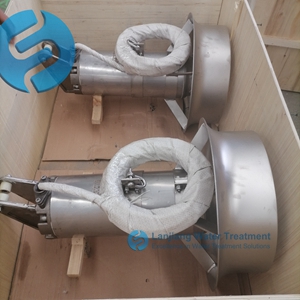When installing a sewage mixer, the following details need to be paid attention to to ensure installation quality, equipment operation efficiency and operation safety:

First, preparation
Equipment selection and inspection:
According to the nature of the treated sewage, the size of the tank, the mixing demand and other factors, choose the appropriate sewage mixer model and power.
Before installation, unpack the mixer, check the packing list, check whether the parts, components, tools and accessories are complete, whether the technical documents and information are complete, and whether the product has a certificate of conformity.
Installation environment preparations:
Ensure that the installation site is relatively open, well-ventilated, safe and reliable, and avoid installing the mixer in a place that is vulnerable to vibration or wear.
Before installation, the site should be leveled and rammed first, and the machine base should be padded to ensure that the pad is firm and level.
Second, the installation process
Installation position and height:
According to the actual situation and design requirements of the sewage tank, determine the installation position and height of the mixer, and mark it.
Avoid installation where there is a barrier in front of the mixer or where the water intake is obstructed.
Bracket and drive system installation:
The bracket is installed on the installation position of the mixer and fixed on the sludge tank or equipment platform to ensure that its structure is firm and stable.
Assemble the transmission system of the mixer (including motor, reducer, bearing, coupling, etc.) and connect to the support.
Impeller installation:
Install the impeller or blade on the shaft of the drive system, and adjust the position and Angle of the impeller as required.
Ensure that the impeller is firmly installed and rotates freely to avoid loosening or vibration during operation.
Electrical system installation:
Install and connect electrical control systems, including cables, control boxes, switches and protection devices.
Ensure that the power cables are well insulated, the connectors and screws are tightly tightened, and the inlet and outlet cables are at a certain height (for example, 1.8 m) above the ground, and are protected by tubes.
The special final switch box is installed to meet the requirements of "one machine, one gate, one leakage, one safety", and repeated grounding treatment is carried out.
Other details:
When installing the cable, arrange the cable to ensure that the cable is not bent and twisted, and the end of the cable is not submerged in water.
When installing, it is necessary to ensure the verticality of the guide rod, and the upper and lower deviation shall not exceed a certain range (such as 10mm), so that the mixer does not produce stuck or excessive friction on the guide rod.
When the mixer is installed, it should be ensured that the lifting point of the main engine hanger or lifting plate positioning hole is in a vertical line with the center of gravity of the mixer.
In the sewage treatment industry, the combination of water and gas is treated with anti-corrosion, such as butter on the guide rod.
Third, commissioning and acceptance
Debugging test:
After the installation is completed, the mixer is debugged and tested to ensure that it can operate normally, and the parameters such as the speed and mixing time of the mixer are adjusted to achieve the best treatment effect.
During the debugging process, pay attention to check whether the vibration, noise, temperature and so on of the mixer are normal, and if there is any abnormality, it should be dealt with in time.
Running test:
Carry out a period of running test to check the running state and effect of the mixer, and adjust and optimize according to the actual situation.
Ensure that the mixer is stable and reliable during continuous operation, and no abnormal phenomenon occurs.
Acceptance and handover:
After installation and commissioning, organize relevant personnel to carry out acceptance work to ensure that the mixer meets the design requirements and use standards.
After passing the acceptance check, it can be transferred to the user unit for normal operation.
Fourth, safety precautions
Personal Protection:
Installation personnel should wear and use personal protective equipment correctly, such as safety helmet, protective glasses, gloves, etc.
Electric shock prevention measures:
Pay attention to prevent electric shock accidents during the installation process, ensure that the power is cut off or take other effective anti-electric shock measures.
Fall prevention measures:
Use protective equipment such as lifting belts and safety ropes to prevent falling accidents during installation.
Other security measures:
Install appropriate barriers and warning signs around the work area, such as fences, warning lights, etc.
Comply with relevant safety operation procedures and regulations to ensure the safe and smooth installation process.
Nanjing LanJiang Water Treatment Equipment Co.,Ltd manufactures equipment for wastewater treatment. We were established in 2001. Since then, we designed and produced submersible mixers, top entry mixers, aerators and other wastewater treatment equipment.
Post time:2024-08-07